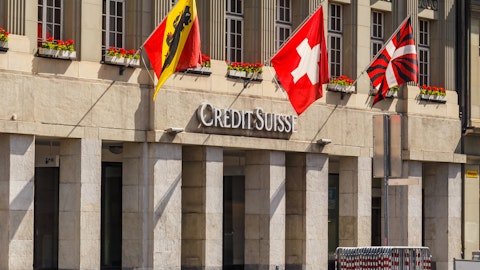Comerica Incorporated (NYSE:CMA) Q2 2023 Earnings Call Transcript July 21, 2023
Comerica Incorporated beats earnings expectations. Reported EPS is $2.01, expectations were $1.86.
Operator: Ladies and gentlemen, thank you for standing by. Welcome to the 2023 Second Quarter Earnings Conference Call. At this time, all participants are in a listen-only mode. Later we will conduct a question-and-answer session. [Operator Instructions] I would now like to turn the conference over to your host, Director of Investor Relations, Kelly Gage. Please go ahead.
Kelly Gage: Thanks, Craig. Good morning and welcome to Comerica’s second quarter 2023 earnings conference call. Participating on this call will be our President, Chairman, and CEO, Curt Farmer; Chief Financial Officer, Jim Herzog; Chief Credit Officer, Melinda Chausse; and Chief Banking Officer, Peter Sefzik. During this presentation, we will be referring to slides, which provide additional details. The presentation slides and our press release are available on the SEC’s website as well as in the Investor Relations section of our website, comerica.com. This conference call contains forward-looking statements. In that regard, you should be mindful of the risks and uncertainties that can cause actual results to vary materially from expectations.
Forward-looking statements speak only as of the date of this presentation and we undertake no obligation to update any forward-looking statements. Please refer to the Safe Harbor statement in today’s earnings release on slide two, which is incorporated into this call as well as our SEC filings for factors that can cause actual results to differ. Also, this conference call will reference non-GAAP measures. And in that regard, I direct you to the reconciliation of these measures in the earnings materials that are available on the website, comerica.com. Now I will turn the call over to Curt, who will begin on slide three.
Curtis Farmer: Good morning, everyone, and thank you for joining our call. Today, we reported second quarter earnings of $273 million or $2.01 per share. Average loans grew to $55.4 billion and a continued focus on fee income helped drive our second highest non-interest income quarter in our history. Expenses declined and our disciplined approach to credit produced a third consecutive quarter of net recoveries. Beyond our compelling financial results, we have launched a transformational expansion and support for small businesses. In the second quarter, we introduced tailored products designed to improve access to capital and enhance cash management capabilities for these important customers, while also providing access to valuable business insight and resources.
Coupled with our recognized SBA achievement, we believe we are well-positioned to be a leading bank for small businesses, providing the tools they need to achieve their goals. Our emphasis on supporting small business is an important part of our overall commitment to communities. You can read more about our other community and sustainability efforts in our 2022 Corporate Responsibility Report that was recently published on comerica.com. Our Southeast and Mountain West expansionary investments continue to perform well as our bankers were active in the market, adding new relationships, and building pipeline. Strong relative economic trends in these regions coupled with the prevalence of target customer base could create opportunity for continued growth over time.
Moving to the summary of our results in slide four. Average loans grew $1.9 billion. Average deposits decreased $3.5 billion due to customer diversification efforts related to industry disruption in the first quarter and the ongoing impact of Fed monetary actions. We saw increased stabilization in both interest-bearing and non-interest-bearing deposits to the second half of the quarter and we believe diversification efforts are largely behind us. As we expected, net interest income declined as we saw the full impact of first quarter deposit flows and funding activity. Credit quality outperformed with another quarter of net recoveries and our criticized loan percentage remains below our historical average. Non-interest income was near-record levels and expenses decline.
Profitability improved in our already solid capital position, as we generated an estimated CET1 ratio of 10.31%, above our strategic target. It always a strong quarter for Comerica and I would now turn the call over to Jim, who will review our results in more detail.

Copyright: kritchanut / 123RF Stock Photo
James Herzog: Thanks, Curt, and good morning, everyone. Turning to slide five. Loan growth came in just above expectations as average balances increased 4% from the first quarter. Increased selectivity drove a slight decline in commitments and utilization increased almost 1%, but remained below historical averages. Growth in our commercial real estate business of over $520 million continue to be driven largely by construction of multifamily and industrial projects, originated over the last two years in addition to the slower pace of payoffs. Recent origination activity and pipeline have significantly declined. Our commercial real estate strategy remains highly selective with a focus on Class A projects and our office exposure is intentionally limited.
Large corporate loans grew $447 million as we won new customer relationships and financed acquisitions for existing customers. National Dealer Services benefited from new customer acquisition and while core plan inventories continue to grow, they remain below pre-pandemic levels. Typical second quarter seasonality resulted in a $325 million increase in average mortgage banker finance loans. However, consistent with our strategic exit of that business, we expect most of our mortgage banker balances to be paid off by the end of 2023. Slide six provides an overview of our deposit activity for the quarter. Average deposit balances declined 5% in line with expectations. Conversations pivoted away from banking industry stability as customers refocused on broader macro-economic issues such as risk of recession and elevated rates.
Throughout the quarter, customer deposit balances continue to normalize and we observed relatively stable trends since mid-May. Industry funding pressures drove deposit competition and interest-bearing deposit costs increased to 237 basis points. However, we feel our dynamic pricing strategy and relationship approach allowed us to maintain our forecasted deposit betas and protect balances. While the rate environment further pressured noninterest-bearing deposits, we continue to view our deposit mix as a competitive advantage providing a more stable and cost-effective funding source than our peers. With strategic investments underway to enhance payments and other treasury management products in addition to our national small business banking strategy, we see opportunities to further improve our attractive deposit profile over time.
As shown on slide seven, our strong liquidity position provided flexibility. We maintained excess cash, repaid maturing FHLB advances, and our remaining liquidity capacity increase. Our quarter-end loan-to-deposit ratio was 84%, still below our 15-year average and strategic actions announced in the second quarter are expected to keep that ratio in the mid-80s at year-end 2023. Cash balances at the holding company position us to repay our $850 million debt due this summer and very light remaining unsecured funding maturities create flexibility to manage funding needs and cash levels over time. Period-end balances in our securities portfolio on slide eight declined almost $900 million with pay downs maturities and a $212 million negative mark-to-market adjustment.
Our security strategy remains unchanged as we stopped reinvesting in the third quarter of 2022 and we maintain our entire portfolio as available-for-sale providing full transparency and management flexibility. Although we have modest treasury maturities through the end of the year, larger scheduled repayments in 2024 and 2025 are projected to benefit liquidity, profitability and our unrealized losses within AOCI. Altogether, we expect a 34% improvement in unrealized securities losses over the next two years. As our portfolio is pledged to enhance our liquidity position, we do not anticipate any need to sell securities and therefore unrealized losses should not impact income. Turning to slide nine. Net interest income decreased $87 million to $621 million, in line with expectations as the benefit of loan volume and one more day were offset by the impact of wholesale funding, lower deposit balances, a shift in deposit mix and deposit pricing.
A significant portion of the funding and deposit activity occurred late in the first quarter, so results reflect a full quarter impact of those actions. With our strategic management of our asset sensitivity position, the impact of rates was nominal. As shown on slide 10, successful execution of our interest rate strategy and the current composition of our balance sheet favorably position us with minimal negative exposure to a gradual 100 basis points or 50 basis points on average decline in interest rates. By strategically managing our swap and securities portfolios, while considering balance sheet dynamics, we intend to maintain our insulated position over time. Our proven discipline produced another quarter of excellent credit quality as highlighted on slide 11.
Once again, we posted net recoveries, although we do not project this trend to continue. Modest migration drove an increase in criticized loans. However, at under 4% of total loans, they remain well below historical averages. Nonaccrual loans declined and inflows to nonaccruals remained low at $17 million. Migration loan growth and a continued weak economic outlook drove the $33 million provision expense and the allowance for credit losses increased to 1.31%. Given the environment, we increased oversight in portfolios with greater relative exposure to elevated rates such as leveraged loans and our commercial real estate business. However, we remain very comfortable with these portfolio metrics and expect continued migration to be manageable.
Noninterest income on slide 12, continues to outperform, growing $21 million from an already strong first quarter. Noncustomer income contributed to results with increases in FHLB dividends and BOLI in addition to customer-related growth in fiduciary and card. Although not shown as a variance to prior quarter, capital markets exceeded expectations as we repeated strong first quarter results. Risk management income related to our hedging strategy saw a modest decrease and should continue to vary based on the rate environment. While noncustomer income can be hard to predict, we expect our strategic investments in products and services to drive further growth in capital-efficient fee income over time. We remain excited about the results of these efforts to date.
Noninterest expenses on slide 13, declined $16 million, in line with expectations. Quarter-over-quarter expenses benefited from several large first quarter items that did not recur, netted $2 million related to the Ameriprise transition, a favorable state tax refund and a real estate asset write-down. Seasonally lower salaries and benefits expense and other noninterest expenses were partially offset by increased outside processing, FDIC insurance and software costs. Modernization efforts were being on track as we incurred a total of $7 million in expenses, advancing our wealth management, corporate facilities, technology and retail strategies. We continue to selectively prioritize strategic investments designed to further enhance our financial results, while remaining committed to prudently managing expenses commensurate with our earnings power.
Slide 14 highlights our strong capital position. With share buybacks pause, capital generation from profitability outpaced loan growth, driving our estimated CET1 further above our target to 10.31%. Strategic actions, including the exit of mortgage banker finance and increased selectivity across the rest of the portfolio, are expected to elevate capital ratios through the end of this year. Higher rates increased unrealized losses in our securities and swap portfolios, reducing our tangible common equity ratio to 5.06%. Adjusting for the impact of AOCI, our tangible common equity ratio would have been 9.22%. Although potential regulatory changes have not yet been proposed, considering our size, portfolio and projections, we feel very good about our ability to support our customers and comply with anticipated capital requirements.
Our outlook for 2023 is on slide 15 and assumes no significant change in the economic environment. We continue to project full year 2023 average loan growth of 8%. The strategic exit of mortgage banker finance and increased selectivity is expected to keep loan balances relatively flat into the third quarter. Our projected full year average deposit decline of 14% to 15% is attributable to quantitative tightening that began last year and the impact of the first quarter of 2023 industry events. Assuming continued normalization of deposit trends and additional FOMC actions, we expect only a modest deposit decline through the second half of the year. We expect our highest year of net interest income in 2023, growing 1% to 2% over last year’s record results.
Although we anticipate short-term rates will remain high through the remainder of the year, our asset sensitivity position is designed to protect our strong profitability by minimizing the negative impact of rates when they decline. Credit quality remained excellent and we expect continued migration to remain manageable. Given the strong performance through the first two quarters, we forecast full year 2023 net charge-offs to remain below our normal 20 to 40 basis points range. Noninterest income exceeded expectations for the first half of the year and we expect full year to grow 7% to 9% over 2022. The benefits from noncustomer income related to FHLB dividends and risk management income are expected to continue, but likely at declining rates as we repay maturing advances and rates normalize.
While we expect strong foreign exchange income and derivative income, we anticipate levels to moderate from the incredible performance to date. Even with potential headwinds in the second half of the year relative to the first half, the overall noninterest income run rate remains compelling. Noninterest expenses are expected to increase approximately 9% year-over-year and 3% of that growth is the result of higher pension expense for 2023. Talent acquisition, investments benefiting our deposit strategy and the enhanced regulatory and compliance focus given our size and business model are expected to create some expense pressure compared to prior guidance. As we look into the third quarter, the cost of filling open positions and other expenses pressure should largely be offset by an expected credit to modernization expense driven by corporate facilities, although the precise timing for this type of credit can be challenging to predict.
Prudent expense management remains a priority as we balance expense pressures with the need to invest for the future. Strong profitability is expected to further grow our capital position in excess of our target and we believe that trend will continue until we resume share repurchases. Now I’ll turn the call back to Curt.
Curtis Farmer: Thank you, Jim. Slide 16 summarizes our competitive advantage with the local delivery of sophisticated, comprehensive products and industry expertise by [indiscernible] bankers. We feel we encapsulate the best features of the largest and smallest competitors. Diversification remains an important tenet of our core strategy and exporting our business model to expansion market has further enhanced our attractive geographic profile. By accelerating certain investments already underway such as payments, small business, wealth management and capital markets, we are elevating the products and capabilities tailored to meet our customers’ needs while enhancing our funding profile, revenue mix, and overall return on capital.
Optimizing our portfolio through the strategic exit of mortgage banker finance and increasing selectivity across the rest of our business lines, prioritizes capital and funding for our target customers. Throughout our 174 years history, we have successfully navigated a number of economic events. And once again, our business model was tested and proved to be sound. As a leading bank for business with strong retail and wealth management capability, we play a unique role supporting our customers as a trusted long-term banking partner. Thanks for your time this morning and now we’d be happy to take some questions.
See also 20 Most Popular Gin Brands in 2023 and Lee Ainslie: Washington Commanders and Other Investments.
Q&A Session
Follow Comerica Inc W (NYSE:CMA)
Follow Comerica Inc W (NYSE:CMA)
Operator: [Operator Instructions] Your first question comes from the line of John Pancari from Evercore. Please go ahead.
Curtis Farmer: Good morning, John.
John Pancari: Good morning. On the deposit growth outlook, I know you lowered your deposit growth expectation despite the end of period deposit is actually increasing and coming in a little bit better than expected. I know you indicated you expect only a modest deposit decline in the back half. Can you maybe just give us some of the color around the rationale for the lowered growth expectation and what type of trends that you expect to develop as you look at the back half? Thanks.
James Herzog: Yes. Good morning, John. It’s Jim. Thanks for the question. Yes. The relatively stable or modest decrease was relative to the second quarter average of $64 billion. We do expect to stay very close to that on average through the end of the year. There are some dynamics churning on below that. Core deposits will probably take a small step down from the average of Q2 just because in the first half of the second quarter, we did have just some very modest runoff. But then again, we added some brokered deposits also that should roughly offset that during the quarter that on an average basis will carry through. So we do think by the end of the year, we’ll still be hovering around that $63 billion to $64 billion number.
We were a little bit elevated on 6/30 as you see on the bar on the right. And so I would not expect all of those balances to stick around. We had $800 million of card that was elevated relative to this typical average. And then we did have some elevated customer balances on 6/30 that I would not expect to stick around either. So that is a little bit of an inflated number. I would maybe stick more to the average guidance of gravitating down to $63 billion to $64 billion by the end of the year on average.
John Pancari: Okay. Great. Thanks for that color. And then separately, also on the deposit front, in terms of noninterest-bearing mix, I know it’s 48% current. Where do you see that bottoming? Already, I think you’re at your pre-pandemic level, you were running at around 48% of total deposits. So where do you think that could bottom? And then separately, sorry if I missed it, but if you can give us your updated through cycle deposit beta expectation, I believe you were taking mid-50s and you’re currently at 47% now. Thanks.
James Herzog: Yes. We are, on average, as well as June 30th, covering in that 47% to 48% area. It’s consistent with what I said early in June at our major investor conference. We still think we are going to dip just slightly below 45%. So think about maybe 44% to 45%. The average ratio was a little bit elevated because it doesn’t consider a little bit of the runoff that occurred early in the second quarter. The June 30th ratio of 47% is a little elevated due to the elevated noninterest-bearing balances that I referred to before. And so I kind of think of us being on a kind of a spot basis to ignore the elevated balances. I really think of us today as being 45% to 46%, and I see that dipping down to maybe 44% to 45% by the end of the year.
Keep in mind that there are a number of variables involved here. Noninterest-bearing flows will be the most important variable. But to the extent we’re successful in bringing back interest-bearing deposits, that could push that ratio down to, and we would, of course, welcome back those interest-bearing deposits. In terms of the beta question, yes, we still think we’re going to end up on a cumulative basis in the mid-50s. I mean right now, I have 56% implied in the guidance, but pretty consistent with what we’ve been saying for the last few months. So we’re still right around that mid-50 area.




